![]()
![]()
![]()
Use LEFT and RIGHT arrow keys to navigate between flashcards;
Use UP and DOWN arrow keys to flip the card;
H to show hint;
A reads text to speech;
91 Cards in this Set
- Front
- Back
|
a
|
a
|
|
|
Questions 1 - 6 are from the Lesson 1 Worksheet
How do we define art? |
Art is many things, as it is everywhere and in everything, not just in paintings and sculptures, but graffiti, and music itself.
Ability, process, and product are but a few of the definitions of art. Ability - art is ability in that we are able to create beautiful things, which can "speak" to us; being creativity. Process - using drawings, paintings, sculptures, architecture, and taking photos, defines art as a process (being the actual creating of the "piece"), which is ever-changing as artists are using and experimenting with different materials. Product - the completed work, whatever that may be. Art is as unique as the artist creating the work, each artist is inspired by different circumstances and upbringing, which are: the personality of the individual, the time period, the place, and the culture. When viewing a piece of art, we need to think about certain things: Why was it created? and What is it's purpose? |
|
|
2) What does it mean to be creative?
|
Creativity is the ability to take an idea and manifest it into reality, which is how art is formed.
|
|
|
3) Why do we create art?
|
We create art for many reasons:
1 - Art and Beauty 2 - Art and our Environment 3 - Art and Truth 4 - Art and Immortality 5 - Art and Glory 6 - Art and Religion 7 - Art and Ideology 8 - Art and Fantasy 9 - Art, Intellect, and Emotion 10 - Art, Order, and Harmony 11 - Art and Chaos 12 - Art, Experience, and Memory 13 - Art in the Social and Cultural Context 14 - Art and Social Consciousness 15 - Art and Popular Culture 16 - Art and the needs of the Artist |
|
|
4) What is the nature of art?
|
a
|
|
|
5) What is the “function” of art?
|
a
|
|
|
6) How can we appreciate art?
|
Acknowledge that art is all around us, learn and understand the terminology that is used to describe art.
|
|
|
7) What is art?
|
Asking the question “What is art?” helps us realize how important art is. It isn't necessarily about what art is, but what art does. By asking and trying to answer the questions, “Why was this created?” and “What was its purpose?” will help us to understand and appreciate art more.
|
|
|
Questions 8 - 15 are from Lesson 1 Study Questions
8) Define and list art processes? |
Ability, process, and product are but a few of the definitions of art.
Ability - art is ability in that we are able to create beautiful things, which can "speak" to us; being creativity. Process - using drawings, paintings, sculptures, architecture, and taking photos, defines art as a process (being the actual creating of the "piece"), which is ever-changing as artists are using and experimenting with different materials. Product - the completed work, whatever that may be. |
|
|
9) What does context mean in examining a work of art?
|
a
|
|
|
10) Ideal beauty is represented by several artists and civilizations in Chapter 1.
Which civilization developed mathematical formulas to represent the ideal human body? |
The Greek
|
|
|
11) What is Frida Kahlo best known for in her artwork?
|
Expressing her mental and emotional pain due to the bus accident she was in at age 18.
|
|
|
12) What does Marc Chagall’s artwork represent?
|
His own mind, but memories of his life in his Russian village
|
|
|
13) What type of media did the artist Faith Ringgold work in to record the story of her life?
|
A patchwork quilt
|
|
|
14) What did Judy Chicago’s work represent?
|
The significant role of women in the arts and society.
|
|
|
15) What artist painted Guernica ? What was the painting about?
|
Pablo Picasso; condemning war
|
|
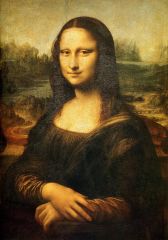
Oil on wood panel 30-1/4" X 21"
|

Questions 16 - 25 are from Lesson 1 Images (might have to repost these using Images)
After reading Chapter 1 in the text, go back and become familiar with the following images: 16) 1-1 Leonardo da Vinci, Mona Lisa , 1503-05 |
|
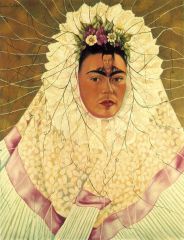
Oil on canvas, mounted on Masonite 24" X 36" (1949)
|
17) 1-7 Frida Kahlo, Diego in My Thoughts ( Diego y yo ), 1949
|
|
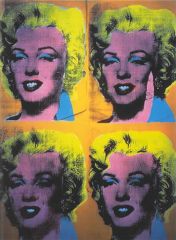
Synthetic polymer paint and silkscreen ink on canvas 30" X 23-7/8"
|
18) 1-9 Andy Warhol, Four Marilyns, 1962
|
|
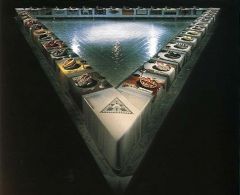
Painted porcelain and needlework 48' X 48' X 48' X 3'
|
19) 1-10 Judy Chicago, The Dinner Party, 1974-79
|
|
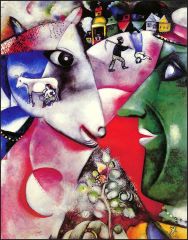
Oil on canvas 6' 3-5/8" X 4" 11-5/8"
|
20) 1-17 Marc Chagall, I and the Village, 1911
|
|
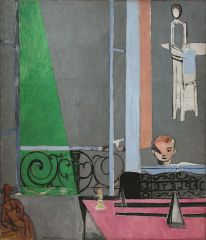
Oil on canvas 8' 1/2" X 6' 11-3/4"
|
21) 1-22 Henri Matisse, Piano Lesson, 1916
|
|
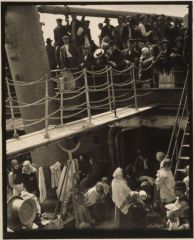
Photograph
|
22) 1-26 Alfred Stieglitz, The Steerage, 1907
|
|
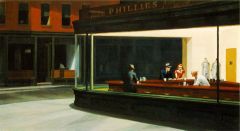
Oil on canvas 30" X 60"
|
23) 1-28 Edward Hopper, Nighthawks, 1942
|
|
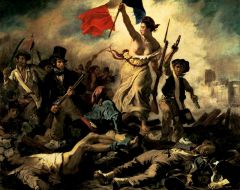
Oil on canvas 8' 6" X 10' 10"
|
24) 1-31 Eugene Delacroix, Liberty Leading the People, 1830
|
|

Fresco 10' X 9' 11"
|
25) 1-36 Jose Clemente Orozco, Epic of American Civilization: Hispano-America, 1932-34
|
|
|
Vocabulary
1. Art Ideology |
pg. 11 an organized collection of ideas, ideologies articulate the way societies look at things, these ideas are formed from commonly held beliefs or are imposed on members of society by ruling or dominant classes, the degree of how much it continues depends on how a society subscribe to it.
|
|
|
2. Art Ability
|
art is the human capacity to make things of beauty and things that stir us; it is creativity
|
|
|
3. Art Process
|
art encompasses acts such as drawing, painting, sculpting, designing buildings, and using the camera to create memorable works; and the definition is ever expanding, as materials and methods are employed in innovative ways to bring forth a creative product
|
|
|
4. Art Product
|
art is the completed work – an etching, a sculpture, a structure, a tapestry; the experience of a work is unique in art as it varies in reactions according to the nature of the individual, time period, place, and culture
|
|
|
5. Performance Art
|
Orlan has been undergoing a series of cosmetic surgeries to create what Western art has set forth as human beauty, is a form of performance art
|
|
|
6. Visual Elements
|
elements, such as line, shape, color, and texture, that are used by artists to create imagery (also termed “plastic elements”)
|
|
|
7. Design
|
the combination of the visual elements of art according to such principles as balance and unity
|
|
|
8. Beauty
|
pg. 3 Beauty is in the eyes of societies beholder, as different cultures view beauty differently
|
|
|
9. Conceptual Art
|
an anti-commercial movement begun in the 1960’s in which works of art are conceived and executed in the mind of the artist. The commercial or communal aspect of the “work” is often a set of instruction for what exists in the artists mind
|
|
|
10. Palette
|
a surface on which pigments are placed and prepared and from which the artist works; the artist’s choice of colors as seen in a work of art
|
|
|
11. Self-Expression
|
pg. ?
|
|
|
12. Renaissance
|
a period spanning the 14th and 15th centuries CE in Europe. The Renaissance (French for “rebirth”) rejected medieval art and philosophy; it first turned to Classical antiquity for inspiration and then developed patterns of art and philosophy that paved the way toward the modern world.
|
|
|
13. Zen
|
A Buddhist sect that seeks inner harmony through introspection and meditation
|
|
|
14. Shamanism
|
pg. 10, a religion based on a belief in good and evil spirits that can be controlled and influenced only by the power of the shaman, a kind of priest.
|
|
|
15. Wordwork
|
A contemporary work of art whose imagery consists of words
|
|
|
16. Allegorical
|
pg. ?
|
|
|
17. Ready-Mades
|
Found objects that are exhibited as works of art, frequently after being placed in a new context with a new title
|
|
|
18. Assemblages
|
A work of art that consists of 3-D objects assembled to create an image. Artists often manipulate preexisting objects in various ways and incorporate them with other media, such as painting or printmaking
|
|
|
19. Pop Art
|
An art style originating in the 1960’s that uses commercial and popular images and themes as its subject matter
|
|
|
20. Outsider Art
|
pg. ?
|
|
|
Artists from study guide:
1. Pablo Picasso |
“Everyone wants to understand art. Why not try to understand the song of a bird? Why does one love the night, flowers, everything around one without trying to understand them? But in the case of a painting, people have to understand”
|
|
|
2. Gustave Courbet
|
“The Beautiful is in nature, and it is encountered in the most diverse forms of reality. Once it is found, it belongs to art, or, rather, to the artist who discovers it”
|
|
|
3. Leonardo da Vinci
|
16th century artist, did the “Mona Lisa” (1503 - 1505)
|
|
|
4. Orlan
|
a French multimedia performance artist who has been undergoing a series of cosmetic operations to create a composite sketch of what Western art has long set for the pinnacle of human beauty
|
|
|
5. Botticelli
|
Sandro Botticelli did “The Birth of Venus” (1486)
|
|
|
6. Joyce Kozloff
|
“Galla Placidia in Philadelphia” (1985) is a mosaic for the Penn Center Suburban Station in Philadelphia
|
|
|
7. Dale Chihuly
|
“Fiori di Como” (1988) is a glass sculpture 70-feet long in the Bellagio Hotel in Las Vegas, and is intended to transport you to Italy’s Lake Como
|
|
|
8. Frida Kahlo
|
“Diego in My Thoughts (Diego y yo)” (1949) A Mexican painter who was injured when a streetcar ran into a bus she was on at age 18, which prevented her from having children
|
|
|
9. Diego Rivera
|
Frida Kahlo’s husband, also an artist, and is the subject of his wives painting, and pain
|
|
|
10. Robert Mapplethorpe
|
“Self-Portrait” (1988) a frightening look at him coming to terms with his battle with AIDS
|
|
|
11. Andy Warhol
|
A pop artist, who painted the “Four Marilyns” (1962) participated in the immortalization of Marilyn Monroe, who took her own life at an early age.
|
|
|
12. Judy Chicago
|
“The Dinner Party” (1974 - 1979) was constructed to honor history’s notable women
|
|
|
13. Jessie Oonark
|
“A Shaman’s Helping Spirits” (1971) is a symbol of the healing spirits associated with the medicine men of her culture
|
|
|
14. Aaron Douglas Odilon Redon
|
his “Noah’s Ark” depicted a version of the story where African Americans are getting the ark ready
|
|
|
15. Marc Chagall
|
his self portrait “I and the Village” is about his childhood in Russia
|
|
|
16. Max Beckmann
|
from Germany, his piece “The Dream” (1921) is a horror filled fantasy
|
|
|
17. Jenny Holzer –
|
a
|
|
|
18. Robert Barry –
|
a
|
|
|
19. Lawrence Weiner –
|
a
|
|
|
20. Paul Cézanne –
|
a
|
|
|
21. Georges Seurat
|
a
|
|
|
22. Jean-François Millet
|
a
|
|
|
23. Henri Matisse
|
a
|
|
|
24. Romare Bearden
|
a
|
|
|
25. Laurie Simmons
|
a
|
|
|
26. Jaune Quick-To-See Smith
|
a
|
|
|
27. Louisa Chase
|
a
|
|
|
28. Alfred Stieglitz
|
a
|
|
|
29. Boucher
|
a
|
|
|
30. Suzanne Valadon
|
a
|
|
|
31. Apelles
|
a
|
|
|
32. Faith Ringgold
|
a
|
|
|
33. Philipp Otto Runge
|
a
|
|
|
34. Edward Hopper
|
a
|
|
|
35. Richard Hamilton
|
a
|
|
|
36. Zaha Hadid
|
a
|
|
|
37. Francisco Goya
|
a
|
|
|
38. Eugéne Delacroix
|
a
|
|
|
39. Suzanne Lacy
|
a
|
|
|
40. Leslie Labowitz
|
a
|
|
|
41. Betye Saar
|
a
|
|
|
42. Miriam Schapiro
|
a
|
|
|
43. Marcel Duchamp
|
a
|
|
|
44. Jose Clemente Orozco
|
a
|
|
|
45. Matthew L. Smith
|
a
|

